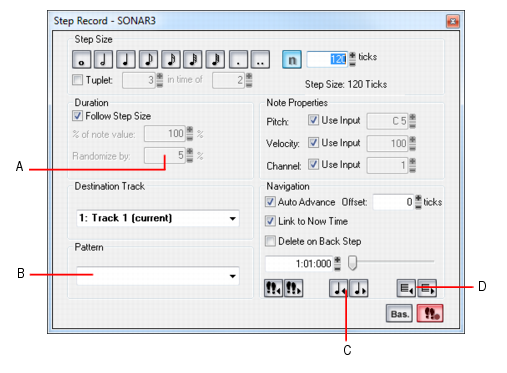Step recording is a method of recording MIDI notes one note or chord at a time. It’s a very easy and precise way to record, but can sound mechanical if used in the wrong situation. You use step recording in its typical form by choosing a step size, such as a quarter note, and then playing a note on your MIDI keyboard. When you play the note, SONAR records the note, and moves the insertion point forward by the distance of the step size (moving the insertion point every time you press a note is the default behavior). You can then record more notes of the same duration by playing notes on your keyboard, or you can change the step size while you’re recording and record different size notes. You can also choose how long the notes you play will sound, as a percentage of the step size. For example, even though you record some notes that have a step size of a quarter note, if you set the Duration field to 50%, the notes will be recorded and displayed as a series of eighth notes, each followed by an eighth rest. The insertion point for each recorded note in this example moves by a quarter note (the step size) each time you record a note. If the duration is longer than the step size, the notes will overlap with the notes recorded at the next step.SONAR displays your step-recorded notes in the Staff view, Piano Roll view, Event List, and Clips pane in real time as you step record them. SONAR also lets you:


and keep the button pressed for a bried moment until the pop-up menu appears, then choose Step Record. The Record button changes to
.
to open the Step Record dialog box.

to move the insertion point forward by the current step size, or click the Step Backwards button
to move the insertion point backward by the current step size. SONAR displays the insertion point location in the Insertion point location field (see Basic mode picture above).


or as small as a 64th note
. You can increase the step size you choose by 50% or 75% by clicking the dot icon
, or double-dot icon
, respectively. You can add different step sizes together by holding down the CTRL key while you click extra icons, or by pressing the + key on the NumPad.

, enable the Tuplet check box, and fill in 3 in the time of 2, which means 3 quarter notes in the time of 2 quarter notes. If you want eighth-note triplets, click the eighth-note icon
, enable the Tuplet check box, and fill in 3 in the time of 2. If you wanted 5 notes in one beat, click the quarter-note icon, enable the Tuplet check box, and fill in 5 in the time of 1.

, and fill in the number of ticks in the Ticks field.



in the Step Record dialog box so that the button is not red. This disables step recording, allowing you to use both the mouse, and any keyboard shortcuts that the Step Record dialog box uses, for other commands.
By default, opening the Step Record window will automatically enable step recording. SHIFT+R is the default shortcut to open the Step Record dialog box. Once the Step Record window is open, you can enable/disable step recording at will without closing the Step Record window: just click the Activate Step Recording buttonin the Step Record dialog box, or press SHIFT+R.
Tip - Searching Documentation
Tip: To search for a specific topic, type your search query in the Search Cakewalk.com field at the top right of this page.
When the search results appear, click which product's documentation you would like to search to filter the search results further.
Note - Using Offline Help
Note: If you prefer to always use offline Help, go to Edit > Preferences > File > Advanced in your Cakewalk software and select Always Use Offline Help.
If you are not connected to the internet, your Cakewalk software will default to showing offline help until an internet connection becomes available.





